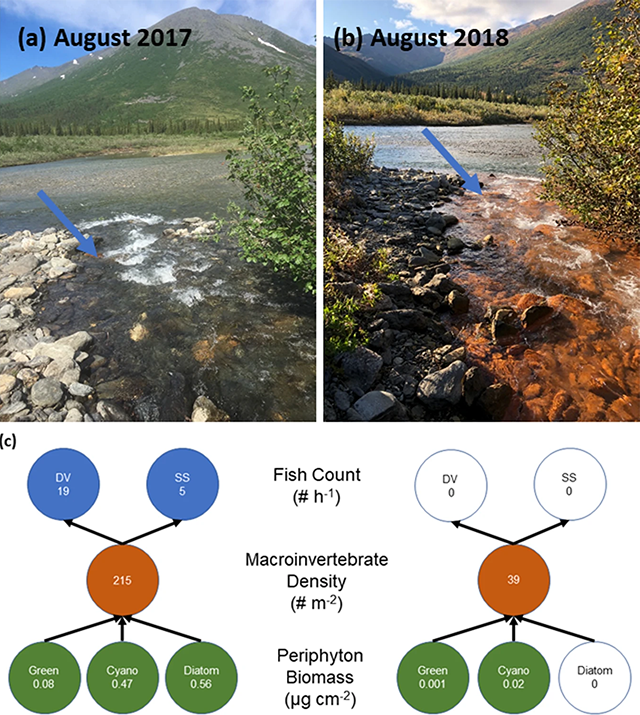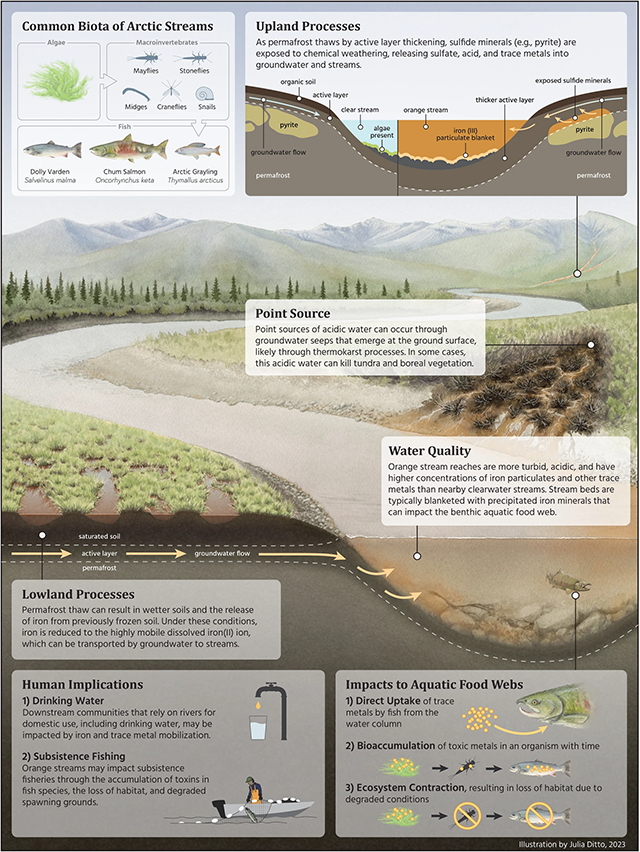
Tracking the effects of iron mobilization on stream food webs. Images of a headwater tributary of the Akillik River in Kobuk Valley National Park, Alaska, illustrating a shift from clearwater on June 12, 2017 (a) to orange stream conditions on August 30, 2018 (b). The blue arrows point to the same boulder near the confluence. c Stream food web data collected in before (September 2017) and after (September 2018) the color change demonstrates the reduction in benthic biofilmproduction, corresponding decline in benthic macroinvertebrate density, and a complete loss of resident fish (DV = Dolly Varden, SS = Slimy Sculpin). The open white circles in (c) represent observations where species absence was documented.
The Arctic is experiencing profound environmental changes due to climate change, with significant alterations in watershed hydrology and biogeochemistry. Hydrology is the scientific study of the movement, distribution, and management of water. Biogeochemistry is the scientific study of the chemical, physical, geological, and biological processes and reactions that govern the composition of the natural environment.
A recent study highlights a concerning phenomenon: the discoloration of streams in Alaska’s Brooks Range, turning from clear to orange. This discoloration is attributed primarily to increased concentrations of iron and toxic metals, a direct result of permafrost thaw.
Permafrost Thaw and Metal Mobilization
Permafrost, perennially frozen ground that has remained so for two or more consecutive years, is a crucial component of the Arctic ecosystem. It acts as a massive reservoir for organic carbon and metals, which, when thawed, begin to mobilize into the watershed. The study documents that this thawing, exacerbated by rapid warming and increased snowfall over the last decade, is leading to the rusting of Arctic streams, visible in their striking orange coloration. This discoloration is primarily due to the mobilization of iron (Fe) and other metals through the process of sulfide mineral weathering.
Impact on Water Quality
The transition of these streams from clear to orange is not just a superficial change. It reflects a significant degradation in water quality, characterized by lower pH levels, higher turbidity, and increased concentrations of sulfate, iron, and trace metals. These environmental shifts pose a considerable risk to the aquatic ecosystems and the species that depend on them. The research indicates dramatic declines in macroinvertebrate diversity and fish abundance in affected streams, pointing to a broader ecological crisis.
Biological Consequences
The biological impact of these changes is profound. The study notes a marked decrease in the diversity and abundance of aquatic life, crucial for maintaining the health of these ecosystems. Fish species, a key component of local subsistence diets, are particularly affected, with populations dwindling as their habitats degrade.
Broader Implications for Local Communities
The implications of these environmental changes extend beyond ecology. For rural communities in Alaska, which rely heavily on subsistence fishing and natural water sources, the degradation of stream quality poses a direct threat to food security and water safety. The research emphasizes the need for ongoing monitoring and intervention to mitigate these impacts and protect community health and livelihoods.

Conceptual models of hypothesized processes contributing to the discoloration of Arctic streams in Alaska’s Brooks Range. The illustration includes consequences for water quality, aquatic food webs, and human implications, including drinking water and subsistence fishing.
Urgent Measures Required
The discoloration of Arctic streams serves as a visible indicator of deeper environmental disturbances linked to climate change. This situation calls for urgent research and adaptive management strategies to address the impacts of permafrost thaw. It highlights the necessity for increased monitoring to track the progression of these changes and for developing strategies to mitigate their adverse effects on Arctic waterways and the communities that depend on them.
Summing Up
The rusting of Arctic streams is more than an environmental curiosity; it is a clarion call highlighting the urgent need for action in the face of climate change. As permafrost continues to thaw, understanding its impact on Arctic hydrology and biogeochemistry becomes crucial. This study lays the groundwork for further research and action, aiming to preserve the Arctic’s ecological integrity and ensure the health and safety of its inhabitants.
